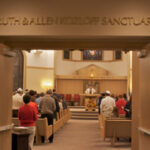 Reform Congregation Oheb Sholom welcomes visitors, and we invite you to participate with us in our religious services. We hope this introduction will provide you with the information you need to understand, feel comfortable, and get the most from your visit.
Reform Congregation Oheb Sholom welcomes visitors, and we invite you to participate with us in our religious services. We hope this introduction will provide you with the information you need to understand, feel comfortable, and get the most from your visit.
Prayer Services and Books:
As Jews, we pray directly to God, without an intermediary such as a minister or priest. The rabbi, meaning “teacher,” leads the services, announces which prayers are being said, provides explanations, and tells the congregants which prayers should be said while standing. If the rabbi is unavailable, a lay member of the congregation will lead the services. The prayer books are written in Hebrew and English, and have English translations for each Hebrew prayer. Some books also have transliteration, i.e., Hebrew written in Roman letters. Since Hebrew reads from right to left, the books will appear to open from the wrong direction, but the pages are numbered so you will be able to follow the services.
Types of Services:
You are welcome to attend any Shabbat service held at Oheb Sholom. While all services contain the same principle elements, there are some differences in the form and specific prayers. The Jewish Sabbath begins at sunset each Friday and concludes at sunset each Saturday. Therefore, Shabbat services are scheduled on Friday evening and occasionally on Saturday mornings. Visitors are encouraged to participate in the services, including the refreshments and/or meals following them. Please see our Calendar for upcoming service times.
Friday evening services last 60 to 90 minutes, and are followed by an “Oneg Shabbat,” a reception starting with blessings over wine and bread, and continuing with refreshments. Saturday morning services last about 2 hours. The service is followed by the blessings over wine and bread, and occasionally refreshments or a buffet lunch in the social hall.
Customs and Practices To Be Aware Of:
As in religious services of all faiths, there are certain customs and practices we follow. (While you may be visiting in order to observe and learn, the synagogue is not a museum, and congregants are there to pray. Therefore, it may be offensive or disruptive if you do not respect the following.)
When attending services, participants may choose to cover their heads as a sign of respect in the sanctuary by wearing kippot (also known as yarmulkes or skullcaps). You’ll notice that some Jewish men and women wear a Tallit (prayer shawl) during services where the Torah is being read, but since that serves a religious purpose, non-Jews do not do so.
During religious services, please do not use cell phones or other electronic devices, use a camera or take pictures, or smoke (actually, the entire synagogue is tobacco-free at all times).
Special Note for Students, Classes or Groups:
Please call the office to let us know which service you would like to attend. If possible, we’ll arrange for someone to talk with the group after the services, to provide additional information about the sanctuary and Judaism, and to answer questions. While you are at the synagogue, feel free to ask the rabbi, ushers, or congregants any questions about the services or Judaism. (Please remember that there is a wide range of knowledge and understanding about Judaism, and varying degrees of religious observance among Jews. Therefore, you may wish to clarify whether their answers reflect the personal beliefs and practices of the individuals you talk with, or whether they are universally accepted within Judaism.)
For additional information, you may want to read “Everything You Need to Know About Shabbat Services” or other articles at the website reformjudaism.org.

